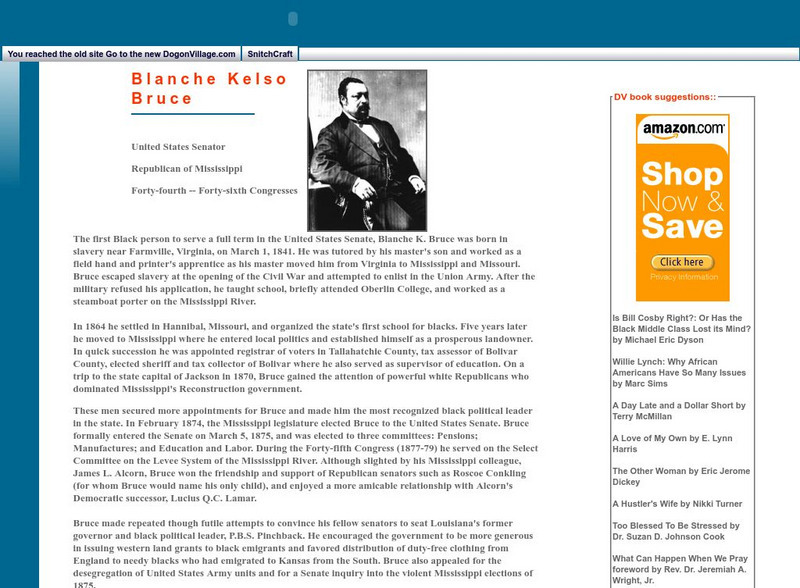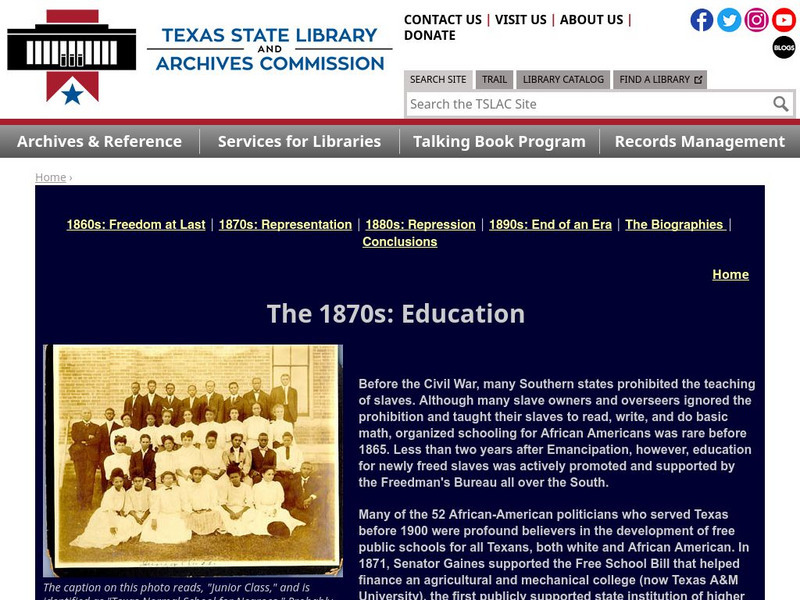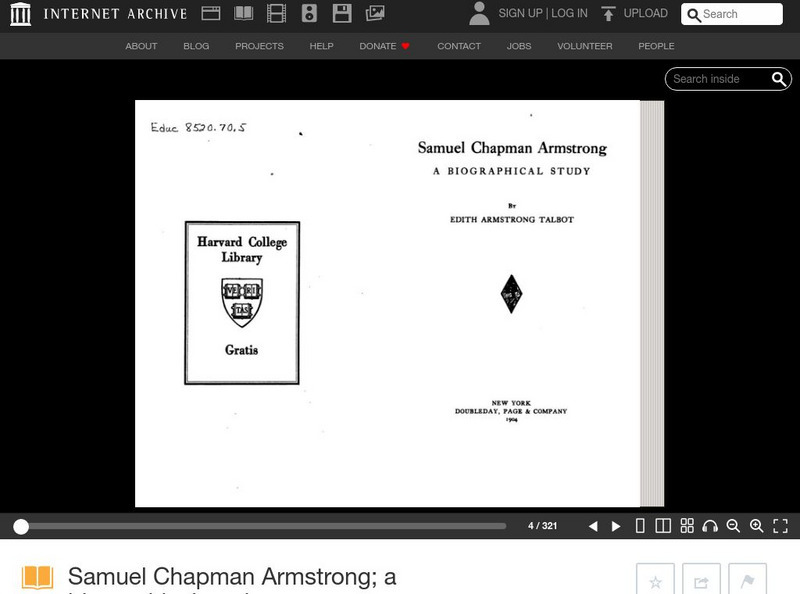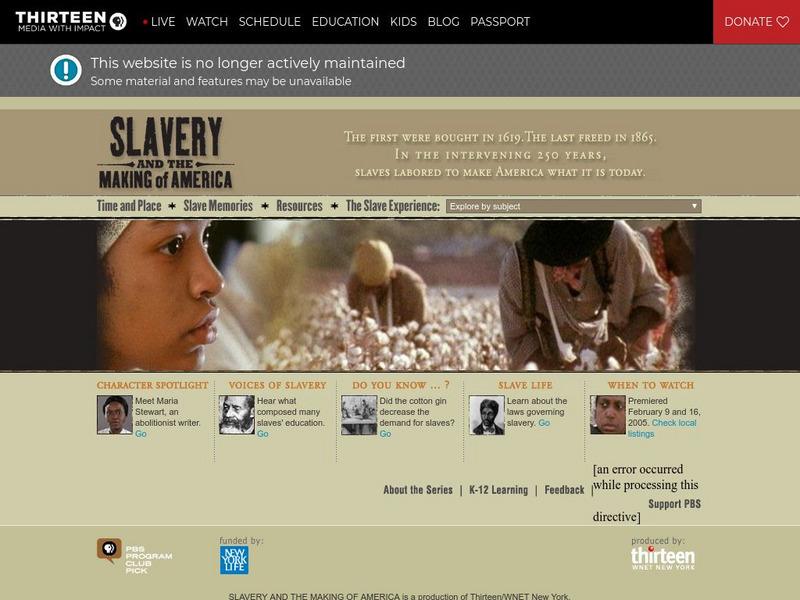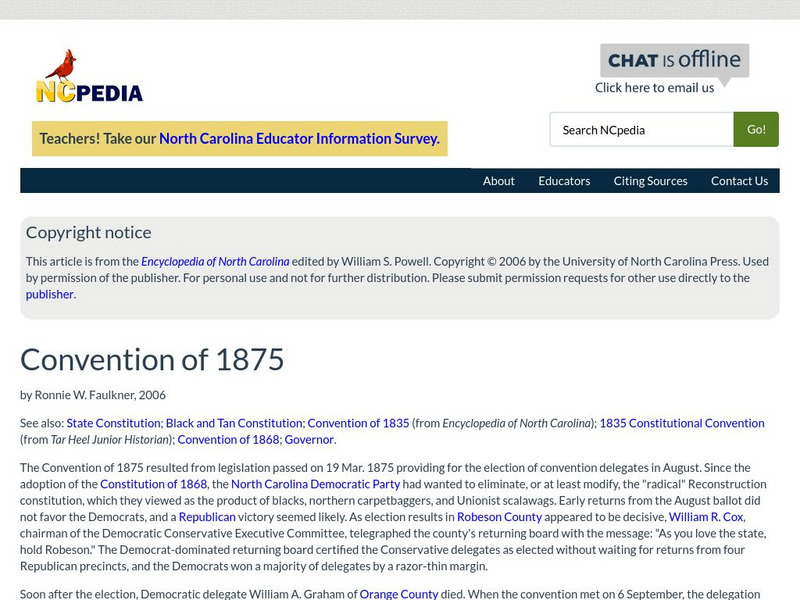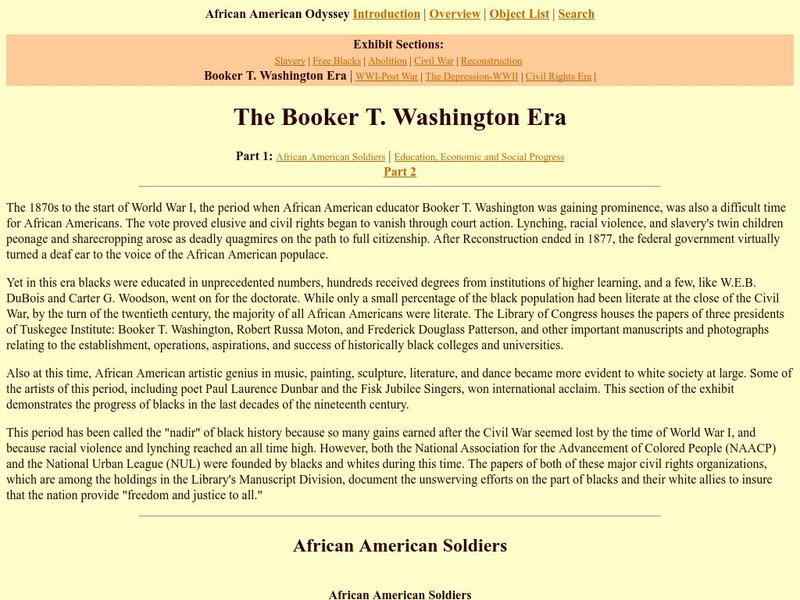Hi, what do you want to do?
US National Archives
Docsteach: From Dred Scott to Civil Rights Act of 1875: Eighteen Years of Change
In 1857, the U.S. Supreme Court ruled in the Dred Scott decision that African-Americans were not citizens of the United States. Yet within 18 years, Black Americans would not only have citizenship, but would be guaranteed the right to...
Other
Black Hills Institute of Geological Research, Inc.: Stan T. Rex
Stan T. Rex is the name given to a Tyrannosaurus Rex skeleton that was excavated and reconstructed by the Black Hills Institute. Stan is sixty-five percent bone and among the most complete T. Rex skeletons in the world that scientists...
PBS
Pbs: Slave to Sharecropper
This collection of resources examines the life and work of freed slaves after the Civil War. Includes questions and answers on sharecropping in the American South, as well as a personal account from a former slave who became a sharecropper.
Woodrow Wilson International Center for Scholars
Woodrow Wilson Center: Digital Archive: North Korea & American Radical Left
A collection of documents on North Korea's ties to groups associated with the American radical left, including the Black Panther Party, in the 1960s and 1970s. The documents were obtained from the personal papers of Eldridge Cleaver, a...
Other
Afgen.com: Address to the Colored People
This page from Afgen.com contains the address delivered to the colored people at Galesburg, Illinois, 1867 by Robert G. Ingersoll. It emphasizes the rights of blacks as a result of the Civil War and Ingersoll encourages African-Americans...
Library of Congress
Loc: From Slavery to Civil Rights
This interactive timeline lets students select an era in the history of blacks in United States. Text tells the highlights of the time and primary source materials are linked that pertain as well.
Other
Dogon Village: Blanche Kelso Bruce
Blanche Kelso Bruce was a Republican Senator from Mississippi, and the first Black U.S. Senator. He advocated for relief for newly freed slaves, for improving navigation on rivers, and for desegregation of the United States Army. He also...
The History Cat
The History Cat: The Crash of '29
Describes what led to the stock market crash of 1929, what initiatives President Herbert Hoover took to try to recover from it, and what the results were.
CommonLit
Common Lit: Book Pairings: "Roll of Thunder, Hear My Cry" by Mildred D. Taylor
Selected (8) reading passages (grades 6-10) to pair with "Roll of Thunder, Hear My Cry" by Mildred D. Taylor. Roll of Thunder, Hear My Cry tells the story of the Logan family combating racial tension and segregation in Mississippi during...
Texas State Library and Archives Commission
Texas State Library and Archives Commission: Forever Free: The 1870s: Education
Read about the development of free education for African Americans following the emancipation of this enslaved population. This article focuses on schools in Texas, including what is now known as Texas A&M University. Includes a...
US National Archives
Samuel Chapman Armstrong: A Biographical Study
A book-length biography of Samuel Chapman Armstrong, founder of Hampton Institute, a historically Black school founded during Reconstruction. The biography was written by Armstrong's daughter, Edith Armstrong Talbot, in 1904. The book is...
PBS
Wnet: Thirteen: Slavery & the Making of America
Using primary documents, oral histories, and other historical resources, discover how the arts of Africa, Europe, and pre-Civil War America influenced the culture of enslaved African Americans.
Library of Congress
Loc: African Immigration: Africans in America: Life in a Slave Society
An excellent overview of the African American experience in America beginning with West Africa during the slave trade, through emancipation and reconstruction, to "New beginnings."
State Library of North Carolina
N Cpedia: Convention of 1875
The Convention of 1875 resulted from legislation passed on 19 Mar. 1875 providing for the election of convention delegates in August. Since the adoption of the Constitution of 1868, the North Carolina Democratic Party had wanted to...
Khan Academy
Khan Academy: Us History: 1844 1877: Life After Slavery for African Americans
Overview of life after slavery for African Americans.
National Humanities Center
National Humanities Center: Toolbox Library: Institutions: Power
This sermon by Rev. Alexander Crummell calls for racial solidarity and self-help, forcefully addressing the question of why African Americans should have their own distinctive institutions.
University of Groningen
American History: Outlines: Rise of Realism
This resource provides a wealth of information about the period of American literature from 1860-1914. There are eight good articles discussing the movements of realism, regionalism, and naturalism, the rise of black American literature,...
Other
Nutrias Online Exhibits: The World of Francois Lacroix
Traces the life of the richest black man in New Orleans before the Civil War and after.
Library of Congress
Loc: African American Odyssey: The Booker T. Washington Era
One section of this "Booker T. Washington Era" page of the LOC's African American Odyssey site is devoted to a very brief biography of Booker T. Washington. Other sections of the page summarize the history of African Americans between...
Columbia University
Columbia University: Columbia University & Slavery Post 1865: Students
African American students began to matriculate at Columbia in significant numbers by the 1920s, but they remain all but invisible in the university's archival records. This site highlights several early black students that continued on...
Starfall
Starfall: Puzzles
In this interactive students click on one of the black statues to break them down into shapes; then they reconstruct the statue by putting the puzzle pieces together, which shows the animal that it represents and replaces the statues...
Teaching American History
Teaching American History: Document Library: Civil Rights Act of 1866
Read the complete text of the Civil Rights Act of 1866, which set out guarantees for citizenship in post-Civil War America as well as the punishments for those who tried to obstruct these guarantees.
Siteseen
Siteseen: American Historama: Battle of Little Bighorn Facts
Provides a summary and list of interesting facts about the Battle of Little Bighorn.
Siteseen
Siteseen: American Historama: Civil Rights Act of 1866
The purpose of the Civil Rights Act of 1866 was to protect ex-slaves (Freedmen) from legislation in the Southern States such as the Black Codes and the Vagrancy Laws and help African Americans obtain equal status under the law.










